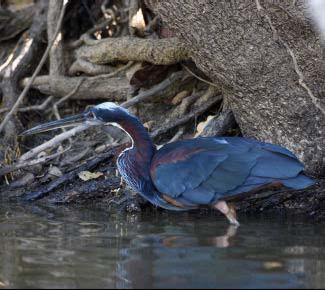


The Agami is an American Indian name for Forest bird. They hunt for fish with long dagger-shaped bills. |
Oddly, every bird book in Bubba’s library described the Agami Heron as ‘Beautiful’, and even beholders know this to be a subjective description. These books are written by ornithologists and they must have a love for particular birds. Something about this bird swept them off their feet. In Carolyn Millers book, ‘100 Birds of Belize’, she said, “The Agami is surely one of the most beautiful Herons in the world”.
In Belize, The Looters Trench Bar at the Chan Chich Lodge near Gallon Jug is a famous gathering place for Birders from around the world. Bubba and I prefer it, not as much because we wish to hobnob (associate) with the birding elite but more because the bartender bends a few rules and serves Bubba Belikin beer in a bowl. My first exposure to the Agami was oddly there on a stroll to the men’s room. I was first struck by this beauty in a lithograph hanging on the wall. My impression was that’s a Japanese brush artist’s rendition of some exotic Asian bird. On returning to the bar I quizzed Norman about it and discovered it was an Agami of the Chan Chich Laguna Seca. I spoke with Carol Miller in the Looters Trench that evening, she said the Lake was a breeding ground for the Agami and they could almost always be found on its east shore. Smitten by its beauty and excited by the chance of a sighting Bubba and I planned a horse back ride to the lake in the morning.
In the World of Aves, with in the order of Ciconiiformes there is a 58 member family called the Ardeidae (Herons), and 16 of those Heron families can be found in Belize. The Agami are one of those living families but they are listed by Orthithological groups as retiring. Agami is an American Indian name for ‘Forest Bird’. They may still be found in parts of Mexico, northern Guatemala and throughout Belize. All of their families hunt for fish with long dagger-shaped bills. The Agami develop elongated plumage on their head and lower fore neck used for courtship displays its colors also intensify during this breeding period.
The colors seem to have the iridescent quality of peacock feathers. The occipital crest is a silvery white unfolded from against a deep black neck. The dark bill and head are set with amber red eyes. It’s under parts are a glossy green. Its throat and fore neck are white with a chestnut stripe down its middle. Its back is light iridescent blue. Its legs are yellow with webbed feet. Males and Females are similar in appearance but juvenile are brown not white like most other herons. They are long legged birds that have specialized in fishing, but frogs, lizards and snails are also on the menu. That afternoon we took a walk down the Sac be trail from the lodge to a quiet stream running through the forest. The book said ‘unmistakable’, so I assumed the Agami would be an easy ID, but not that it would be there the first moment I started to look. In the stream stood a very beautiful Heron, frozen, postured with neck cocked and ready to spear something unseen by me below the still water. I said in a whisper to Bubba,’ this isn’t true, it can’t be this quick and easy. I watched as long as Bubba could stand it and then let him toss a rock into the water to show be how it flew, but it didn’t fly it merely back-stepped into the bank and disappeared. We found another almost as easy the next day after we arrived at the lake. “Seca” is a word the locals use for dry and the lake had been reduced from lack of rain to only shallow marsh along its east shoreline. Bubba found an empty Apple Snail shell in the grass as large as a tennis ball and immediately hypothesized that it had been eaten by an Agami and was probably a major food source when the lake failed to produce fish.
True, the status of this beautiful creature in our world is retiring, but it has obliviously found a hold out in the sanctuary around Chan Chich and Gallon Jug. The Wild Life Conservation Society’s conservationists in collaboration with The Belize Government and the Belize Audubon Society have been protecting wildlife in Belize since1980. Their mission is a noble one, “save wildlife and wild lands by understanding and resolving critical problems that threaten key species and large, wild ecosystems.” To contribute you can simply visit www.wcs.org/belize and specify your donation go to the activities at Gallon Jug. Bubba did!
